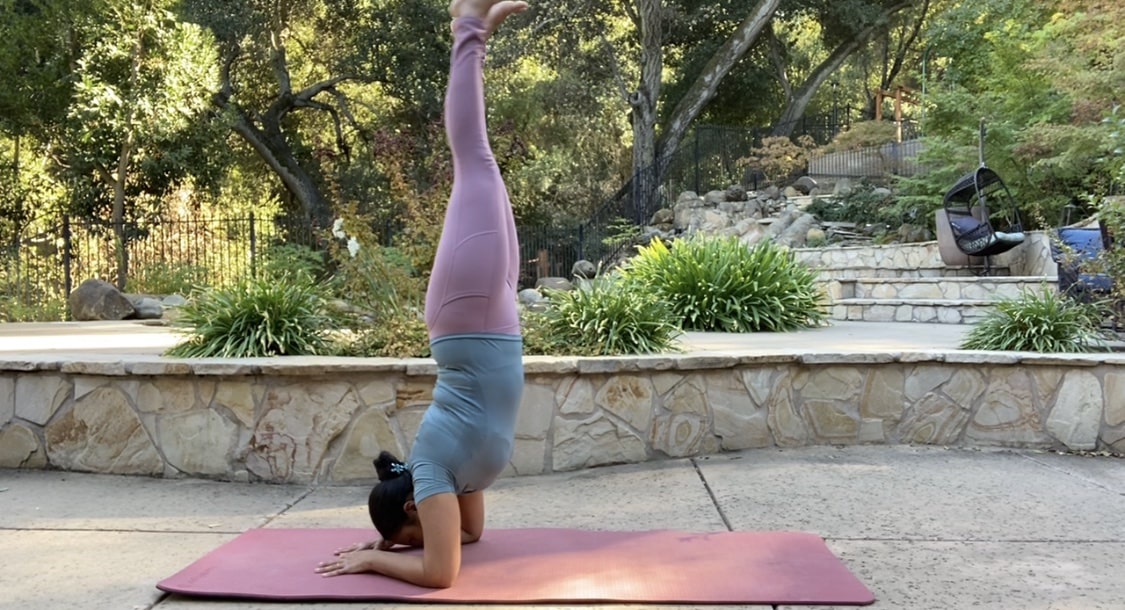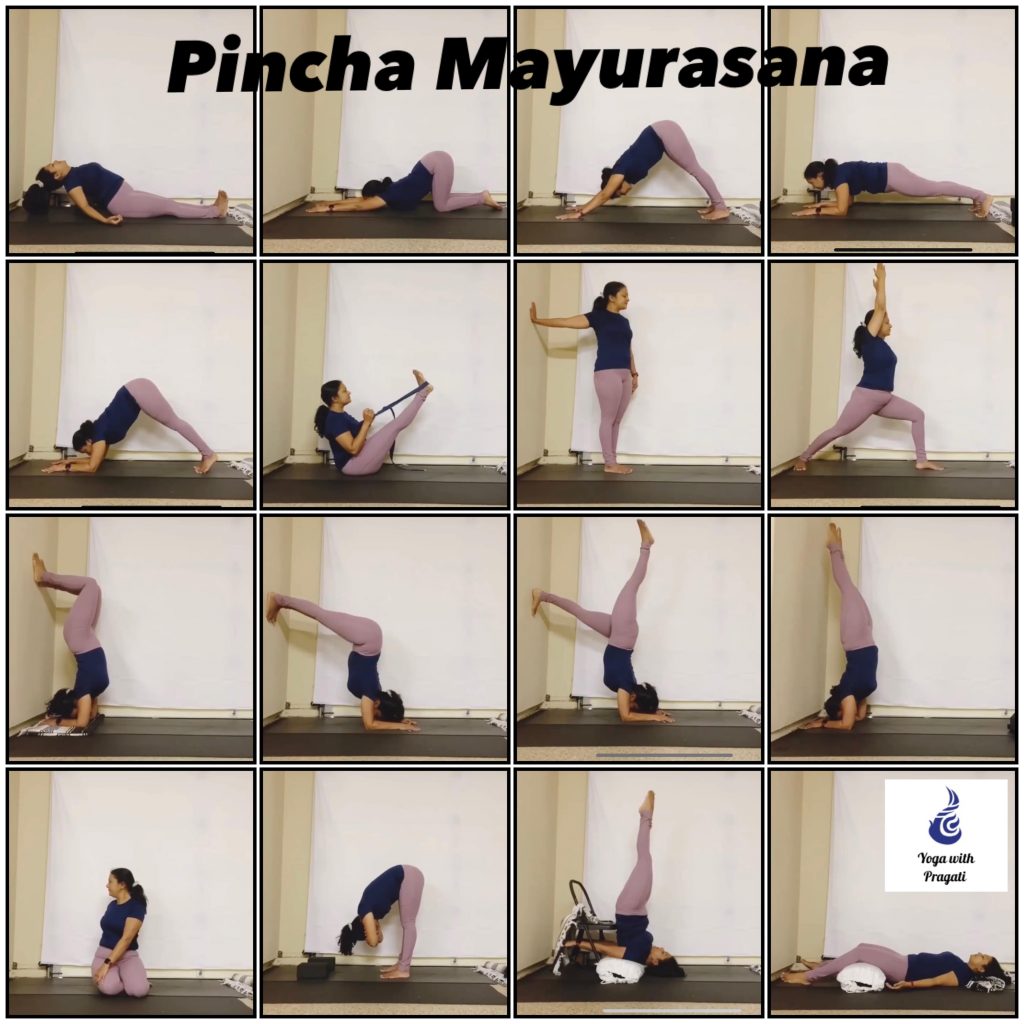Most important facts about Pincha Mayurasana with 8 Tips and Tricks

What is Pincha Mayurasana ? Why you should do Pincha Mayurasana?
Pincha means a feather, and Mayura means a peacock. When it is about to rain, a peacock lifts its trailing tail feathers and spreads them to form a fan. In this posture, the trunk and legs are lifted off the floor, and the body is balanced on the forearms and palms. The Pose resembles a peacock starting his dance.
This Pose is also called forearm stand since it involves balancing the entire body in an inversion on the forearms. It is an asymmetrical inverted balancing arm support pose.
“Like a Peacock, your beauty is multiplied when you spread your wings.
Don’t be afraid to be who you are –
each peacock feather is flawed and imperfect, but collectively they create something of great beauty.
Your flaws are what make you perfect.”
~Anonymous
Just like other inverted poses, Pincha Mayurasana revitalizes the whole body. It takes the weight off the legs, relieving strain. By inverting the inner organs, its activate parts that are sluggish. It improves blood circulation and tones the glandular system. It helps in improving concentration as blood is brought to the brain, and it is a marvelous aid to sleep.
Pre-requisites for Pincha Mayurasana:
- When the shoulders are not open enough, the core and lower back move into extension
and cause the banana back. So it is important to work on poses to open up the shoulders like shoulder flossing, Dolphin pose, Gomukhasana ( Cow face Pose), Garudasana (Eagle Pose), etc. With stability in the shoulders joints themselves, the shoulder blades are free to mobilize on the rib cage, and there is more freedom in the thoracic spine to extend and in the rib cage to breathe. - Mobility in the thoracic spine is important as the more extension available in the thoracic spine, and the less, the lower back and cervical spine have to do. Due to tight shoulders, Pincha Mayurasana may be more challenging than Handstand for some people.
- It is also important to have a strong core. So any core building poses like planks, boat pose, revolved abdominal poses, leg lifts, etc are really useful to fire the core.
Steps to get into Pincha Mayurasana:
- Kneel down in front of a wall and place your forearms parallel to each other about shoulder-distance away.
- Fingers are spread out and press the index and middle fingers against the wall.
- Make sure the elbows are right below the shoulders and pronate your shoulders so that
the shoulder blades are moving away from each other. - Raise the shoulders up and look at the mat in between your forearms.
- Straighten the legs and walk in, raising the trunk and hips, trying to get the hips stacked
above the shoulders as much as you can. - Walk one foot in and exhale and kick with the other leg at the back.
- Keep the head and shoulders lifted. Stretch the trunk and keep the legs together and at
the wall. You can also check Yoga Inversion Bench Headstand Prop Upside Down Chair for Feet Up and Balance. - Keep the hips stacked over shoulders stacked over elbows with the core engaged.
- Hold for 20-0 seconds with even breathing.
- Exhale and come down and stay with your head down for a few seconds
Benefits of Pincha Mayurasana
- Strengthens the muscles of the shoulders, arms, and back
- Tones the spine and stretches the abdominal muscles.
- Develops balance
- focus and concentration
- Stimulates the upper chakras
- Relieves stress and depression
Avoid or use caution when practicing Pincha Mayurasana:
- Back, shoulder, or neck injury
- Headaches
- High blood pressure
- Menstruation
- Pregnancy
- Heart condition
Tips and Tricks for balance in Pincha Mayurasana:
- Keep the elbows in and the wrists apart. Press the palms down.
- Keep the upper arms and shoulders lifted. Extend the lumbar up and take the sacrum and coccyx in.
- Stretch the heels firmly to raise the hips.
- Keep the legs activated to keep the core engaged.
- If you have a solid headstand in your practice, there is an easy way to transition to Pincha Mayurasana by placing the feet at the wall with legs bent and pushing firmly into an elbow, and using the core to lift up the head off the ground.
- As the balance in Pincha Mayurasana improves, it may be time to take the practice off the wall. In that case, after kicking with the back leg, bend the other legs and pull that knee into the chest to activate the core and after gaining full balance, gradually work on straightening the legs.
Also, check YogaToes Stretcher & Toe Separator,If you are suffering from Bunions, Hammer Toes. - Push the thumbs into each other while your hands are spread out on the mat. This helps with pushing shoulders away from the mat.
- For better balance, it helps to keep both knees bent after the legs are up in the air. Then balance in the tetter-totter position with the top knee moving away from the trunk and the bottom knee pulled into the trunk. After finding stability with balancing with both the hips, keeping the core engaged, work on straightening the leg.
Props that support Pincha Mayurasana:
- Tie a strap above the elbows to keep the arms in.
- Hold a block between thumbs and index fingers to keep the wrists apart.
- Balance with the feet away from the wall for a more vertical stretch.
- Feet at the wall while facing the wall with legs parallel to the mat.

Suggested sequence for Pincha Mayurasana practice:
- Thoracic spine opening with blocks
- Anahatasana/ Puppy pose
- Adho Mukha Svanasana/ Downward facing dog
- Forearm Plank
- Ardha Pincha Mayurasana/ Dolphin pose
- Navasana/ Boat pose
- Shoulder opening at the wall
- Virbhadrasana 1/ Warrior 1
- Headstand to Forearm transition
- Wall facing Pincha Mayurasana
- One leg off with wall facing Pincha Mayurasana
- Pincha Mayurasana
- Bharadvajasana
- Uttanasana
- Sarvangasana/ Shoulder stand
- Shavasana
Balance in Pincha Mayurasana can be fleeting. Remember just like everything else in life, it is more about the journey than the final destination. So enjoy the process towards achieving this beautiful, uplifting pose.
For full access to this class and over 100+ other classes divided into Beginner’s, Intermediate
and Advanced, subscribe to Yoga with Pragati at the link below:
Iyengar Yoga Monthly Live & Video on demand
Check for the FREE Trial 5 Class package.
Check out the website: Yogawithpragati
Wanting to set up a daily Home Yoga Practice? Check out 10 Tips To Help Your Daily Yoga Practice









